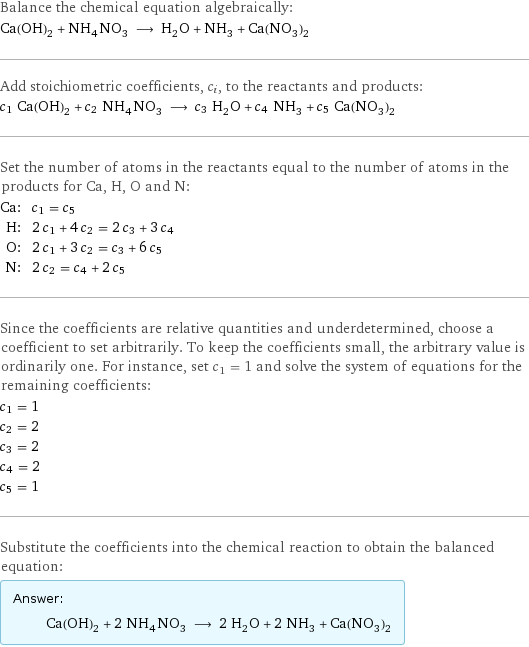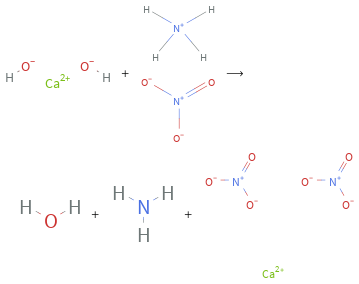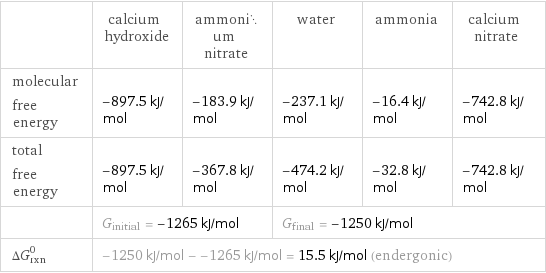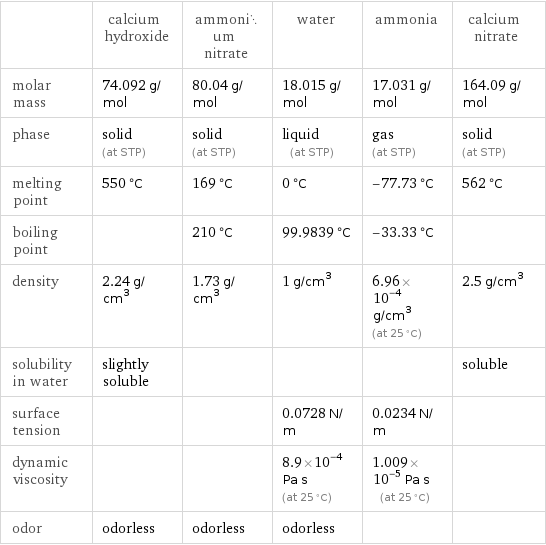Input interpretation

Ca(OH)_2 calcium hydroxide + NH_4NO_3 ammonium nitrate ⟶ H_2O water + NH_3 ammonia + Ca(NO_3)_2 calcium nitrate
Balanced equation

Balance the chemical equation algebraically: Ca(OH)_2 + NH_4NO_3 ⟶ H_2O + NH_3 + Ca(NO_3)_2 Add stoichiometric coefficients, c_i, to the reactants and products: c_1 Ca(OH)_2 + c_2 NH_4NO_3 ⟶ c_3 H_2O + c_4 NH_3 + c_5 Ca(NO_3)_2 Set the number of atoms in the reactants equal to the number of atoms in the products for Ca, H, O and N: Ca: | c_1 = c_5 H: | 2 c_1 + 4 c_2 = 2 c_3 + 3 c_4 O: | 2 c_1 + 3 c_2 = c_3 + 6 c_5 N: | 2 c_2 = c_4 + 2 c_5 Since the coefficients are relative quantities and underdetermined, choose a coefficient to set arbitrarily. To keep the coefficients small, the arbitrary value is ordinarily one. For instance, set c_1 = 1 and solve the system of equations for the remaining coefficients: c_1 = 1 c_2 = 2 c_3 = 2 c_4 = 2 c_5 = 1 Substitute the coefficients into the chemical reaction to obtain the balanced equation: Answer: | | Ca(OH)_2 + 2 NH_4NO_3 ⟶ 2 H_2O + 2 NH_3 + Ca(NO_3)_2
Structures

+ ⟶ + +
Names

calcium hydroxide + ammonium nitrate ⟶ water + ammonia + calcium nitrate
Reaction thermodynamics
Gibbs free energy

| calcium hydroxide | ammonium nitrate | water | ammonia | calcium nitrate molecular free energy | -897.5 kJ/mol | -183.9 kJ/mol | -237.1 kJ/mol | -16.4 kJ/mol | -742.8 kJ/mol total free energy | -897.5 kJ/mol | -367.8 kJ/mol | -474.2 kJ/mol | -32.8 kJ/mol | -742.8 kJ/mol | G_initial = -1265 kJ/mol | | G_final = -1250 kJ/mol | | ΔG_rxn^0 | -1250 kJ/mol - -1265 kJ/mol = 15.5 kJ/mol (endergonic) | | | |
Equilibrium constant
![Construct the equilibrium constant, K, expression for: Ca(OH)_2 + NH_4NO_3 ⟶ H_2O + NH_3 + Ca(NO_3)_2 Plan: • Balance the chemical equation. • Determine the stoichiometric numbers. • Assemble the activity expression for each chemical species. • Use the activity expressions to build the equilibrium constant expression. Write the balanced chemical equation: Ca(OH)_2 + 2 NH_4NO_3 ⟶ 2 H_2O + 2 NH_3 + Ca(NO_3)_2 Assign stoichiometric numbers, ν_i, using the stoichiometric coefficients, c_i, from the balanced chemical equation in the following manner: ν_i = -c_i for reactants and ν_i = c_i for products: chemical species | c_i | ν_i Ca(OH)_2 | 1 | -1 NH_4NO_3 | 2 | -2 H_2O | 2 | 2 NH_3 | 2 | 2 Ca(NO_3)_2 | 1 | 1 Assemble the activity expressions accounting for the state of matter and ν_i: chemical species | c_i | ν_i | activity expression Ca(OH)_2 | 1 | -1 | ([Ca(OH)2])^(-1) NH_4NO_3 | 2 | -2 | ([NH4NO3])^(-2) H_2O | 2 | 2 | ([H2O])^2 NH_3 | 2 | 2 | ([NH3])^2 Ca(NO_3)_2 | 1 | 1 | [Ca(NO3)2] The equilibrium constant symbol in the concentration basis is: K_c Mulitply the activity expressions to arrive at the K_c expression: Answer: | | K_c = ([Ca(OH)2])^(-1) ([NH4NO3])^(-2) ([H2O])^2 ([NH3])^2 [Ca(NO3)2] = (([H2O])^2 ([NH3])^2 [Ca(NO3)2])/([Ca(OH)2] ([NH4NO3])^2)](../image_source/0228e25cd1ba0ddce91bbf868fbbe57d.png)
Construct the equilibrium constant, K, expression for: Ca(OH)_2 + NH_4NO_3 ⟶ H_2O + NH_3 + Ca(NO_3)_2 Plan: • Balance the chemical equation. • Determine the stoichiometric numbers. • Assemble the activity expression for each chemical species. • Use the activity expressions to build the equilibrium constant expression. Write the balanced chemical equation: Ca(OH)_2 + 2 NH_4NO_3 ⟶ 2 H_2O + 2 NH_3 + Ca(NO_3)_2 Assign stoichiometric numbers, ν_i, using the stoichiometric coefficients, c_i, from the balanced chemical equation in the following manner: ν_i = -c_i for reactants and ν_i = c_i for products: chemical species | c_i | ν_i Ca(OH)_2 | 1 | -1 NH_4NO_3 | 2 | -2 H_2O | 2 | 2 NH_3 | 2 | 2 Ca(NO_3)_2 | 1 | 1 Assemble the activity expressions accounting for the state of matter and ν_i: chemical species | c_i | ν_i | activity expression Ca(OH)_2 | 1 | -1 | ([Ca(OH)2])^(-1) NH_4NO_3 | 2 | -2 | ([NH4NO3])^(-2) H_2O | 2 | 2 | ([H2O])^2 NH_3 | 2 | 2 | ([NH3])^2 Ca(NO_3)_2 | 1 | 1 | [Ca(NO3)2] The equilibrium constant symbol in the concentration basis is: K_c Mulitply the activity expressions to arrive at the K_c expression: Answer: | | K_c = ([Ca(OH)2])^(-1) ([NH4NO3])^(-2) ([H2O])^2 ([NH3])^2 [Ca(NO3)2] = (([H2O])^2 ([NH3])^2 [Ca(NO3)2])/([Ca(OH)2] ([NH4NO3])^2)
Rate of reaction
![Construct the rate of reaction expression for: Ca(OH)_2 + NH_4NO_3 ⟶ H_2O + NH_3 + Ca(NO_3)_2 Plan: • Balance the chemical equation. • Determine the stoichiometric numbers. • Assemble the rate term for each chemical species. • Write the rate of reaction expression. Write the balanced chemical equation: Ca(OH)_2 + 2 NH_4NO_3 ⟶ 2 H_2O + 2 NH_3 + Ca(NO_3)_2 Assign stoichiometric numbers, ν_i, using the stoichiometric coefficients, c_i, from the balanced chemical equation in the following manner: ν_i = -c_i for reactants and ν_i = c_i for products: chemical species | c_i | ν_i Ca(OH)_2 | 1 | -1 NH_4NO_3 | 2 | -2 H_2O | 2 | 2 NH_3 | 2 | 2 Ca(NO_3)_2 | 1 | 1 The rate term for each chemical species, B_i, is 1/ν_i(Δ[B_i])/(Δt) where [B_i] is the amount concentration and t is time: chemical species | c_i | ν_i | rate term Ca(OH)_2 | 1 | -1 | -(Δ[Ca(OH)2])/(Δt) NH_4NO_3 | 2 | -2 | -1/2 (Δ[NH4NO3])/(Δt) H_2O | 2 | 2 | 1/2 (Δ[H2O])/(Δt) NH_3 | 2 | 2 | 1/2 (Δ[NH3])/(Δt) Ca(NO_3)_2 | 1 | 1 | (Δ[Ca(NO3)2])/(Δt) (for infinitesimal rate of change, replace Δ with d) Set the rate terms equal to each other to arrive at the rate expression: Answer: | | rate = -(Δ[Ca(OH)2])/(Δt) = -1/2 (Δ[NH4NO3])/(Δt) = 1/2 (Δ[H2O])/(Δt) = 1/2 (Δ[NH3])/(Δt) = (Δ[Ca(NO3)2])/(Δt) (assuming constant volume and no accumulation of intermediates or side products)](../image_source/e7bbdadaac334d0888d3a6708aea0ab0.png)
Construct the rate of reaction expression for: Ca(OH)_2 + NH_4NO_3 ⟶ H_2O + NH_3 + Ca(NO_3)_2 Plan: • Balance the chemical equation. • Determine the stoichiometric numbers. • Assemble the rate term for each chemical species. • Write the rate of reaction expression. Write the balanced chemical equation: Ca(OH)_2 + 2 NH_4NO_3 ⟶ 2 H_2O + 2 NH_3 + Ca(NO_3)_2 Assign stoichiometric numbers, ν_i, using the stoichiometric coefficients, c_i, from the balanced chemical equation in the following manner: ν_i = -c_i for reactants and ν_i = c_i for products: chemical species | c_i | ν_i Ca(OH)_2 | 1 | -1 NH_4NO_3 | 2 | -2 H_2O | 2 | 2 NH_3 | 2 | 2 Ca(NO_3)_2 | 1 | 1 The rate term for each chemical species, B_i, is 1/ν_i(Δ[B_i])/(Δt) where [B_i] is the amount concentration and t is time: chemical species | c_i | ν_i | rate term Ca(OH)_2 | 1 | -1 | -(Δ[Ca(OH)2])/(Δt) NH_4NO_3 | 2 | -2 | -1/2 (Δ[NH4NO3])/(Δt) H_2O | 2 | 2 | 1/2 (Δ[H2O])/(Δt) NH_3 | 2 | 2 | 1/2 (Δ[NH3])/(Δt) Ca(NO_3)_2 | 1 | 1 | (Δ[Ca(NO3)2])/(Δt) (for infinitesimal rate of change, replace Δ with d) Set the rate terms equal to each other to arrive at the rate expression: Answer: | | rate = -(Δ[Ca(OH)2])/(Δt) = -1/2 (Δ[NH4NO3])/(Δt) = 1/2 (Δ[H2O])/(Δt) = 1/2 (Δ[NH3])/(Δt) = (Δ[Ca(NO3)2])/(Δt) (assuming constant volume and no accumulation of intermediates or side products)
Chemical names and formulas

| calcium hydroxide | ammonium nitrate | water | ammonia | calcium nitrate formula | Ca(OH)_2 | NH_4NO_3 | H_2O | NH_3 | Ca(NO_3)_2 Hill formula | CaH_2O_2 | H_4N_2O_3 | H_2O | H_3N | CaN_2O_6 name | calcium hydroxide | ammonium nitrate | water | ammonia | calcium nitrate IUPAC name | calcium dihydroxide | | water | ammonia | calcium dinitrate
Substance properties

| calcium hydroxide | ammonium nitrate | water | ammonia | calcium nitrate molar mass | 74.092 g/mol | 80.04 g/mol | 18.015 g/mol | 17.031 g/mol | 164.09 g/mol phase | solid (at STP) | solid (at STP) | liquid (at STP) | gas (at STP) | solid (at STP) melting point | 550 °C | 169 °C | 0 °C | -77.73 °C | 562 °C boiling point | | 210 °C | 99.9839 °C | -33.33 °C | density | 2.24 g/cm^3 | 1.73 g/cm^3 | 1 g/cm^3 | 6.96×10^-4 g/cm^3 (at 25 °C) | 2.5 g/cm^3 solubility in water | slightly soluble | | | | soluble surface tension | | | 0.0728 N/m | 0.0234 N/m | dynamic viscosity | | | 8.9×10^-4 Pa s (at 25 °C) | 1.009×10^-5 Pa s (at 25 °C) | odor | odorless | odorless | odorless | |
Units
